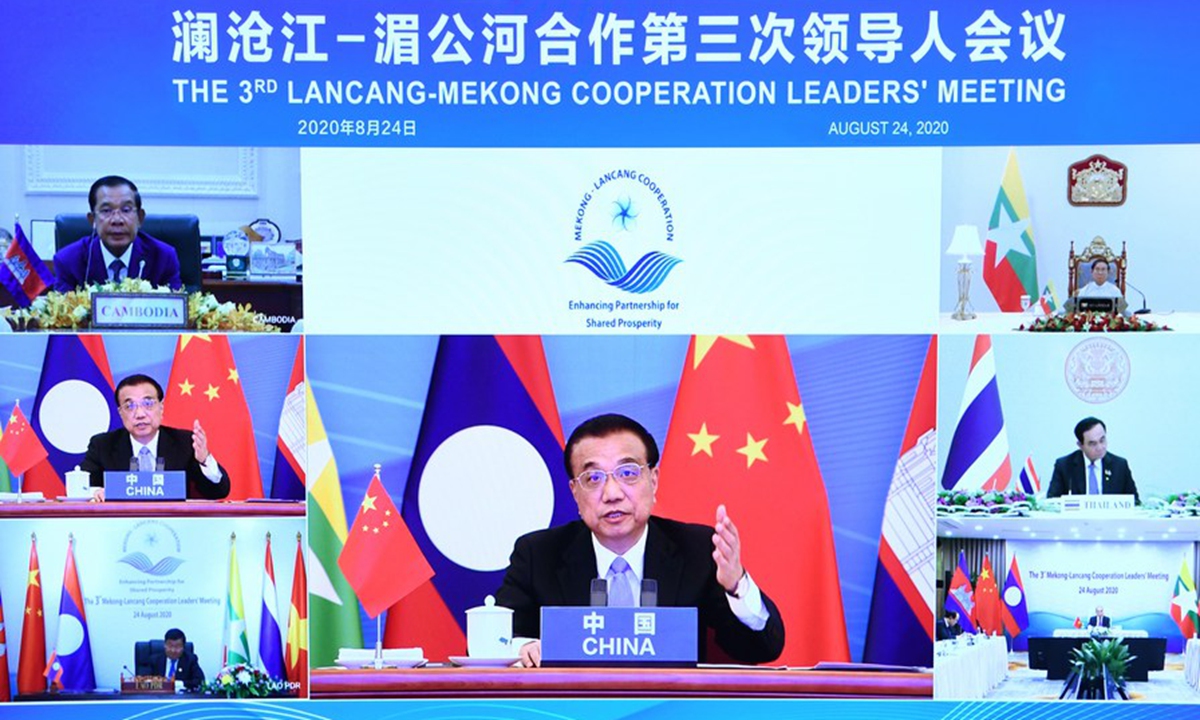Mekong River Commission applauds China's pledge to offer more data
By Hu Yuwei Source: Global Times Published: 2020/8/26 1:15:08

Chinese Premier Li Keqiang attends the third Lancang-Mekong Cooperation Leaders' Meeting via video link at the Great Hall of the People in Beijing, capital of China, Aug. 24, 2020. (Xinhua/Rao Aimin)
The Mekong River Commission (MRC) on Tuesday welcomed the pledge by Chinese Premier Li Keqiang that China will share year-round hydrological data with the Mekong countries. The pledge is expected to help uphold mutual trust and rebut outside accusations against China that have politicized the issue as the second South China Sea dispute.
The MRC expressed its desire to work with China to promote effective use of the data, in a statement on its official website on Tuesday. Chinese experts said it was a positive response, following China's assurances about its aim to strengthen exchanges and dispel misunderstandings in the region during a virtual leader's meeting among the six member states on Monday.
Today, the Mekong River still matters for the livelihoods of some 60 million people along it. The sharing of hydrological information has deepened trust and benefited people in the region, but it has never been an easy decision. Chinese hydraulic experts told the Global Times that the sharing of hydrological information is not merely a technical issue; it is also related to sovereignty and national security.
During the rainy season, China, as an upstream country, puts through about 16 percent of the water in the lower Mekong, which sounds like a limited contribution. But during the dry season, water from melting ice on China's Tibetan Plateau reportedly accounts for more than 24 percent of the Mekong River's total water volume, according to a statement sent to the Global Times by Zhai Kun and Deng Han, who are experts on the Mekong region with the School of International Studies at Peking University. They said this is a crucial contribution for the lower Mekong countries, which usually suffer from the tropical monsoon climate and frequent seasonal droughts and floods.
More than 10 global experts from the US, UK, Mekong River countries, and cross-national organizations agreed that cascade reservoirs along China's Lancang River help alleviate the droughts downstream when they attended a virtual international seminar held on July 14.
Upstream countries, which can normally use water independently, are generally perceived as having little incentive to participate in water resource cooperation with downstream countries. But China does not follow this rule.
China has long been aware of its responsibilities and obligations in water resource cooperation in the Mekong region, reflected in its heightened interactions with downstream countries in recent years.
In 1996, China became a dialogue partner of the MRC, an inter-governmental river basin organization initiated by four downstream countries, and in 2002 signed the first hydrological data sharing agreement with the MRC, promising to share data about daily river flows and rainfall data upstream during the rainy season.
In the following decades, China expanded the scope of its data sharing.
Up to now, China has held 23 cooperation dialogues with the MRC, and has provided the MRC with hydrological data during the flood season for 17 consecutive years since 2003. This has been valuable in flood control, drought relief and disaster reduction in the downstream areas, Zhai and Deng said.
Premier Li's remarks show that China is ready to extend the hydrological data sharing to dry season from monsoon.
As a severe drought hit countries in the Lancang-Mekong River basin from late 2019 to early 2020, some downstream countries appealed to China to release more water through upstream dams.
Some US media outlets cited reports by US-funded institutions that blamed China for the disaster, with a possible intention to provoke and undermine mutual trust between countries in the region, analysts said.
Such reports alleged that dams built in China controlled the upstream flow to use the water for domestic hydropower or irrigation.
Chinese researchers refuted this reckless accusation by collecting and analyzing hydro-meteorological data covering both upstream and downstream areas via state-of-the-art methods.
"Whenever there is a drought in the Mekong region, ties between upstream and downstream countries are put under pressure," said the statement from Zhai and Deng. "The gaps and misunderstanding between regional countries can be used as a political tool by some countries and institutions to intervene in the affairs of the Mekong River region and undermine regional peace."
China has always made efforts to avoid politicization of the regional water resource issue, they said.
Regional development that China is involved in has often faced challenges and even provocation from abroad. Only when the six countries in the Mekong region join together to resolve disputes via scientific research and solid evidence can the rumors be completely crushed, Bi Shihong, a professor at the Center for China's Neighbor Diplomacy Studies and School of International Studies of Yunnan University, told the Global Times on Monday.
Posted in: DIPLOMACY